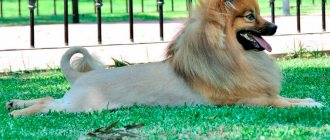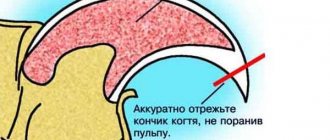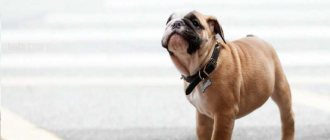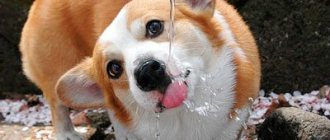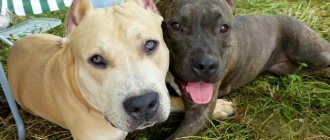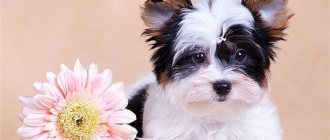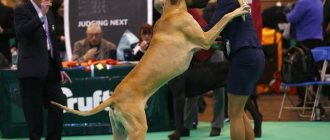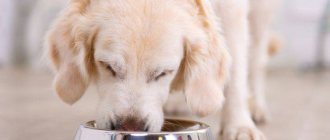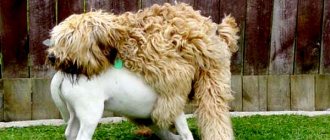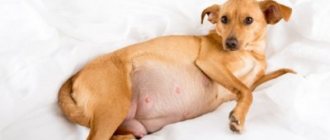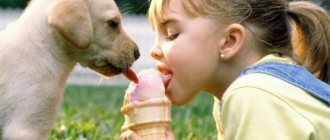There are dogs that respond to the phrase “Who’s going to get a haircut now?” they run away in horror and, huddled in a corner, begin to glare angrily with their eyes and bare their teeth.
Seeing such a scene, someone might feel sorry for the dog and doubt the appropriateness of the owner’s intentions to cut his dog’s hair: what are these painful manipulations with scissors for?
Haircut without problems: techniques and secrets
Dogs that react nervously to the word “haircut” and timidly tuck their tails at the sight of scissors are not uncommon. Unfortunately. And the animal’s dislike for this painless and, in general, pleasant procedure is the owner’s fault.
Dogs need to be taught to groom, comb, and other hygiene procedures from the time , just like to use a leash and collar. To do this, when the puppy is playing, gently stroke his fur with a comb. Repeat this action. A comb should not evoke fear, but only positive emotions.
Important : you need to start accustoming your puppy to grooming from 3 months.
All procedures should be enjoyable and evoke positive emotions for both participants in the process. And then the dog will get used to standing calmly when it is combed, cut, and washed. And he won’t make frightened eyes at the sound of a hair dryer and hair clipper being turned on.
Experts advise
- Grooming a walking dog, in a good mood.
- Groom your dog dry and clean. Wet wool quickly makes scissors dull.
- Grooming a combed dog. This will make the cutting process easier and allow you to do it smoothly and accurately.
- Groom your dog on a table that you can move around freely.
- It is better not to turn the dog around while grooming unless absolutely necessary. This is additional stress for her.
- If there is a large amount of work, divide it into several stages so as not to overtire the dog and not cause him negative emotions from the grooming process.
- No aggression from the owner or sudden movements.
- Start cutting from the ears, paws, and muzzle. The torso is cut last - the scissors (clipper) are guided along the hair growth, parallel to the torso.
- It is more convenient to cut the neck, body, belly and groin with a clipper.
- The paw pads, muzzle and base of the tail are trimmed only with scissors.
- When cutting the muzzle, the scissors go in the direction “away from the eyes”.
- Particular care when cutting requires delicate places - the groin, armpits, base of the tail.
- The first haircut with a clipper should not be “zero” - very short, until your hand is “full”, so as not to injure the animal.
- During the procedure, praise the dog, stroke it, and talk to it. There are known cases when pets immediately stopped trembling on the table as soon as they began to be showered with compliments.
What kind of dogs need to be groomed?
It doesn't hurt to consider the breeds that need to be trimmed. Moreover, it is advisable to do this regularly.
This procedure is mandatory for long-haired breeds. A haircut helps to avoid tangles and matted lumps, which can cause the formation of wounds on the skin and inflammation.
Knowing why a dog cannot be cut, the owner of such an animal will begin to take this procedure more seriously. If there is still a need for it, then it is best to entrust such work to a competent specialist. He will choose the optimal haircut for your pet, which will definitely not harm him.
Article rating
A difficult case - grooming aggressive dogs
What to do when the dog is an adult, large, with a pronounced dominant type of behavior and is not accustomed to cutting its hair? Such a complex case requires a special approach . And it is better if this approach is performed by a specialist.
To do this, the dog must be taken to a grooming salon. On foreign territory, aggressors behave differently than they are used to at home . There are different orders here, and the animal feels it.
But! There is another important aspect to this behavioral problem. Very often, it is not shepherd dogs and giant schnauzers who bare their teeth, growl and snarl, but handsome ones - Yorkies and plush toy poodles. Experts attribute this “paradox” to the fact that owners, as a rule, are not involved in raising their “kids.” Couch pets get away with a lot, and over time it becomes a problem .
But why do usually affectionate Yorkshire terriers suddenly begin to hate scissors and hair dryers, which is why they fly into a rage? Finding out the reasons for a dog’s aggression allows you to correct its reaction to a haircut and correct its behavior during grooming.
3 reasons for aggression in dogs
- Fear
Decorative dogs are more likely to suffer from this problem. Perhaps their first experience with scissors was painful or had consequences. Something really scared them. The fear was fixed in the mind by the image of clanking scissors or the noise of a hairdryer.
This cause of an aggressive reaction to a haircut is difficult to eliminate. Only patience and affection will help. Experts advise calling a groomer to your home for the first time and not taking your dog to the salon, where everything is foreign, scary and causes a panic attack in the animal.
The cause of fear is easy to recognize; just watch the dog. If she is cheerful and friendly in any situation when she is not threatened by scissors and a machine, then that’s the problem.
- Nervous type
Nervous dogs often behave aggressively in stressful situations. Incomprehensible manipulations with fur, strange sounds, unfamiliar salon furnishings, the absence of the owner nearby, strange hands - all this causes severe discomfort in a choleric dog with an excitable nervous system .
She is lost, does not know how to behave, and finds a way out in aggression.
This reason can be eliminated by calling a groomer to your home, who will confidently and affectionately cut the pet’s hair in the presence of the owner.
Advice: it is better if the dog is groomed by the same groomer or family member.
- Dominant type
It is difficult for a novice groomer to cope with a domestic tyrant who establishes his own rules. For an owner who has been playing by his dog’s rules for a long time, this is a completely impossible task.
Therefore, only a specialist can cope with the dominant type of aggressor on his own territory. Therefore, in this case, the haircut should be done in a salon.
It’s not difficult to identify a dominant dog – one that won’t let you near its bowl and won’t allow you to take the ball away from it.
Note : aggressive dogs of large breeds are always clipped with a muzzle, using special methods of fixing the obstinate dog, sometimes (as a last resort) - under general anesthesia.
Which dogs should not be cut?
Separately, it is worth considering the question of which dogs should not be cut. This group includes representatives of certain breeds for which such a procedure is contraindicated.
Important! If the owner does not know for sure whether dogs can be groomed, then he should ask this question to an experienced specialist.
Here are some dogs that should not be cut:
- Retweaver.
- Husky.
- Malamute.
- Labrador.
The list can also include short-haired breeds, as well as dogs with a thick undercoat. After a haircut, it may stop growing fully.
Complications after haircut
A dog that is not accustomed to standing still during a haircut, even in the skillful hands of a groomer, can twitch at a crucial moment and provoke a cut or other trouble .
The cut will be treated with an antiseptic, but the aftereffects of other troubles can make themselves felt after some time and scare the owner with the pet’s strange behavior.
There was a case when, after another visit to the salon groomer, a Pekingese couldn’t go “big” for a day - he sat down during a walk, “put his tail” under himself, whined pitifully and looked reproachfully at the owner. The owner's heart was breaking; she did not understand at all what was happening to the dog. Later, experienced “colleagues” suggested that this strange behavior was a reaction to damage in the groin area during haircuts , as well as hair cut too short in the genital area. It took a week of treatment with antiseptics, persuasion and caresses during daily hygiene procedures to remove the consequences of an unsuccessful visit to the salon.
Important: for some dogs, especially males, it is not recommended to shave the hair in the groin area very short, “to zero.”
Similar behavior of the dog - strange sideways jumps, constant squats, a desire to hide - was also described by the owner of a cocker spaniel. Each time after a haircut, the dog needed time to recover.
He didn’t have any pain, he just felt uncomfortable with his hair cut, he was embarrassed and suffered from the “humiliation” he experienced.
But the essence of a proper haircut is precisely that the dog should not experience humiliation and psychological discomfort . And there should be extremely pleasant sensations. And this is achieved in only one way - love for the animal, and with the only message - to do good to him: so that his eyes look, his ears don’t itch, his paws don’t hurt, nothing bothers him anywhere, and they turn around after your dog in admiration: “Ah! What a beautiful girl!"
And kind words, as you know, are pleasant to a dog.
Why is the original haircut dangerous?
Burns are not the worst thing. Dogs' hair grows differently than humans' hair. This is especially true for dogs with thick fluff. The follicle has several stages of growth. Together with the hair that is ready to fall out, young fur also grows out. If you shave at the root, the spine will “die.” In place of the coarse hair, fluff will begin to grow. This is a protective reaction of the body. One haircut is enough to change the structure and shade of the coat. Why does the “fur coat” lighten? There is less pigment in down than in awn.
After two haircuts, it will be almost impossible to return to your previous appearance. Tangles will appear and the dog will look like a stray sheep. You will have to shave your pet regularly.
Some owners are faced with another phenomenon - follicular arrest. This is slow fur growth. Sometimes after cutting the fur, the animal walks “naked” for up to 2 years. Fur-bearing dogs are at risk: chow chows, labradors, huskies. Scientists cannot yet identify the cause of the disease. They suspect that this is due to poor circulation. Circulation worsens in any case, since defenseless skin is constantly freezing.
If you think that bloodsuckers will not touch a bald pet in the summer, you are mistaken. An animal without hair is a haven for mosquitoes, fleas, ticks and other parasites.
Sometimes the reason for shaving a dog is heavy shedding. Yes, you will be able to get rid of tangles and hair falling out right now. However, the problem will become more pressing in the future. This is a disservice. Losing all hairs at once is stressful for your pet. It is natural for a dog to shed gradually. You can help him by combing out the dead fur. The furminator copes well with this task. What else can we do for companions?
Features of caring for these dog breeds
Trimming dog breeds with undercoat is a mistake. Instead of helping the animal in the hot season, harm is done to the body. Deprived of a natural defense mechanism, the dog's body begins to overheat, not properly carrying out the process of thermoregulation. The dog does not have sweat glands on the body, except for the paw pads, so there is no process of evaporation of moisture through the surface of the skin. Cooling of the body occurs in dogs through the mucous membranes. In the heat, an animal begins to breathe more actively, opening its mouth slightly, thereby cooling itself.
Grooming a dog with an undercoat causes ultraviolet rays to hit the skin directly, causing the development of solar dermatitis, hemangiomas, hemangiosarcomas, and actinic dermatosis. The process may result in the development of squamous cell carcinoma.
During the hot season, the owner can help the dog by studying some features and recommendations. The main ones are:
- The animal must have a place where it can hide in the shade (applies to private houses and suburban areas). A dog living in an apartment environment can lie down on the tiles. For such cases, you can purchase a special mat that has cooling properties.
- The dog must have unlimited access to clean drinking water.
- To improve air microcirculation in the undercoat, experts recommend regularly brushing the coat.
- Active physical activity, like regular walks, should be moved to the morning or late evening, when the heat subsides.
- You can allow your animal to swim if you have access to a body of water.
Animal grooming is a fashion trend that has appeared quite recently. There are no special reasons to carry out the procedure on all dogs.
Animals with long hair can be slightly shortened using scissors, without using more radical methods. Otherwise, there are risks of developing not only heat exchange disorders, but also other pathological conditions, including oncology.
Basic Rules
In order for the dog to enjoy each grooming session and not experience stress, it is necessary to follow certain rules to make the process as comfortable and effective as possible:
- The animal should not be afraid . To do this, it is necessary to accustom him to the manipulations and sound of working tools from the first months of life. You should start grooming your puppy at the age of 2.5-3 months, starting with simple hygienic treatment. The main condition for the dog’s calm attitude towards the process is the patient and caring attitude of the master. You should not be rude, impatient, raise your voice or punish your pet in any way, especially for the first time. The dog should be as comfortable as possible.
- No movement . The animal must be fixed, since any sudden movement will not only ruin the future hairstyle, but also cause physical harm to sensitive skin.
- Physical comfort . The table on which manipulations are carried out must be covered with a rubberized coating so that the paws do not slip.
Is your dog sad? Maybe his bangs are bothering him?
The answer to the question of why you should cut your dog's hair is simple: to improve your pet's quality of life. Even short-haired dogs need to tidy up their paws - trim the hair between the toes and pads. It often rolls into dense tangles, which prevent the dog from moving normally and provoke the development of inflammatory skin diseases. It is especially important to do this in spring and autumn, when it is damp and muddy outside, as well as in winter to prevent snow from sticking. Trimming the fur on the paws makes grooming easier and makes your pet feel more comfortable.
Some breeds require regular ear trimming. For example, Yorkie babies whose ears sag under the weight of their fur without being trimmed. In poodles, hair grows inside the ear canal, which interferes with the normal release of wax and provokes various diseases, so the hair from the ear canal must be plucked.
Delicate areas are often trimmed, again to make the animal more comfortable.
All these types of haircuts are called hygienic, they are recommended for dogs of all breeds, with the exception, perhaps, of the Chinese Crested, Chihuahua and Xoloitzcuintle (Mexican Hairless Dog): these dogs simply have nothing to cut.
Many breeders mistakenly believe that in the summer the dog needs to be cut to keep it cool. In fact, wool provides four-legged pets with good thermoregulation. But this does not mean you can’t cut your dog’s hair in hot weather. Firstly, in the summer animals shed a lot, and secondly, it is easier to notice a tick on a dog with a haircut - it is necessary to examine the dog after every walk.
Getting ready for a haircut
In order for the procedure to be safe, successful, and the result to meet your expectations, you need to follow simple rules.
Accustom the dog to the procedure
The most important thing is to teach your pet to calmly endure all manipulations. This needs to start from an early age. You should comb, wash and dry your baby carefully, without causing him discomfort or pain, and be sure to reward him with a treat after the procedure. You can read more about this in the article “Caring for Dog Coat.” So that you can safely use the machine at home, the dog should not be afraid of it. During the game, you can turn on the instrument so that your pet “gets acquainted” with the buzzing object. After several times the animal will stop paying attention to it, and you will be able to use the device for its intended purpose.
Preparation
Before the procedure, take your baby for a walk and feed him so that he can stand quietly for a while and allow the manipulations to be carried out. In advance, just before the haircut, comb your pet well, wash it with a special shampoo with emollients (balm, conditioner), dry it with a hairdryer or let it dry naturally and comb it thoroughly. You cannot cut a shaggy or wet dog - the result may be unpleasantly surprising.
Place and tool
To cut your dog's hair at home, you need to select and prepare a place. It is more convenient to do this on a high, flat surface, such as a table. Workplace lighting plays an important role. You must be able to see clearly what you are doing. Provide access to the table from all sides so that the pet can stand quietly in one place and you can walk around it. Cover the table with a thin rubber or silicone mat that your dog's paws won't slip on.
Prepare a comb - an ordinary thin single-row, preferably metal, and brushes that you use in everyday care. Scissors must be professional, hairdressing, well sharpened. A regular hair clipper won't work either. This should be a special grooming tool. No need to purchase an expensive professional model. A simple animal clipper or scissors will be enough.
